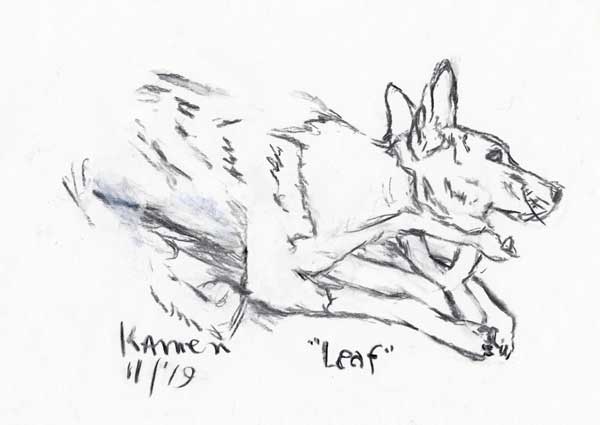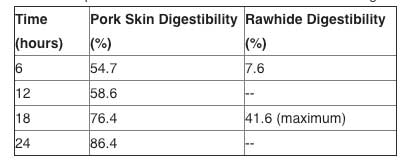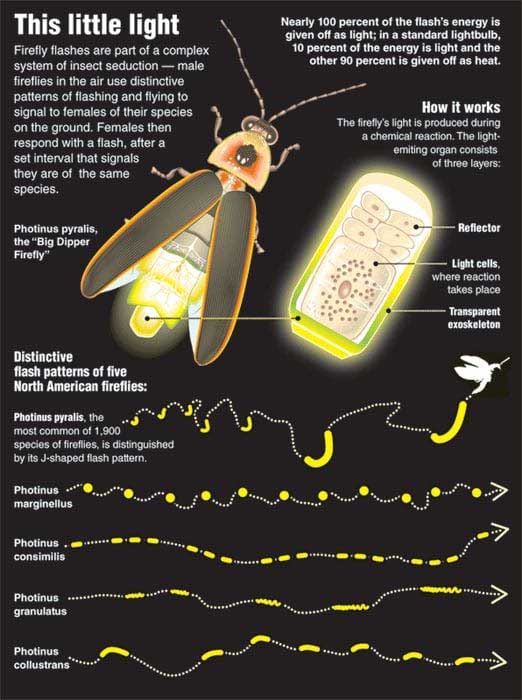Page 11 <previous page > <next page>
SOME HEALTH & SCIENCE NEWS Leaf with a Nylabone.
Leaf with a Nylabone.
1. Vet Hospitals Report more Parvo during COVID.
2. The Problem with Rawhide Chewies for Dogs.
3. Fireflies.
Thursday, July 16, 2020
The Canine Review
VET HOSPITALS REPORT MORE PARVO DURING COVID – BUT PET INSURER TRUPANION SAYS THEY DON’T SEE IT
by Emily Brill
Last week, high-end specialty and emergency veterinary hospital network BluePearl announced in a press release that, based on data from all ninety of its hospitals throughout the United States, there had been a 70% increase in canine parvovirus cases during the COVID-19 pandemic compared with the same period in the previous five years. “Canine parvovirus is a highly contagious virus that commonly causes GI [gastro-intestinal] disease in young, unvaccinated dogs,” Dr. Alex Gallagher summarizes in the Merck Veterinary Manual.
BluePearl declined to provide any of the data and spokeswoman Laura Fourniotis noted in an email that the data has not been released to any member of the public. “Our researchers are still in the early stages of their investigation,” she wrote in an email when asked if TCR could see the data. “We are…looking for possible causes of the increase and determining what the implications are for this and other preventable companion animal diseases,” chief medical officer Dr. James Barr wrote in the media release. Dr. Barr declined to be interviewed.
Manhattan, Too
Although BluePearl apparently does not know what to make of its own data, other members of the profession had some insight to offer. The Animal Medical Center in midtown Manhattan is the largest veterinary nonprofit hospital in the world—and it is also home to one of the world’s busiest veterinary emergency departments. Staff doctor Ann Hohenhaus has worked at AMC since 1986. Asked about BluePearl’s announcement and what she had been seeing at AMC in recent months regarding parvovirus cases, Dr. Hohenhaus outlined recent observations at the hospital that make her certain that cases are on the rise.
What is the basis for her conclusion that parvo cases are up this year? The AMC overnight admission log, she explained to TCR.
‘Two pets admitted [in a single night for parvo] that were not from the same family is another thing that makes me think [the number of cases is] up”
“Every morning at AMC, around 5 o’clock, there is a list sent out to everybody in the hospital that says what got admitted overnight. And there has been parvo on the list. It’s unusual to see parvo on that overnight admit list because the reality is, we don’t see that much parvo in New York City—at least not in the Animal Medical Center neighborhood.” She added, “I would be willing to bet that most of the parvo cases come in on emergency because your dog is acutely, critically ill. You don’t make an appointment for that. You just show up. So, that’s why I think the overnight admission list is probably a good reflection of that.”
“There was one [recent] particular morning when the overnight admission list had two pets with parvo. We will often see that because people will get two puppies from the same litter. But, when I looked, the last name of these two pets was not the same.”
“The fact that I’m even seeing parvo on that admission list tells me that it’s up,” she added. “And the fact that in a single night there were two pets admitted that were not from the same family is another thing that makes me think it’s up.” (Update: Following publication, Dr. Hohenhaus informed TCR through a spokeswoman that AMC had another parvo case admitted last night.)
In fact, Dr. Hohenhaus, who is a certified veterinary journalist, warned her own readers last week on AMC’s popular blog – as New York City dog parks reopened as part of Phase 3 – of the risk of exposure to parvovirus and other infectious diseases. She felt that many pet owners, including even her own clients (as she said in her interview with TCR) had missed important vaccination deadlines during the pandemic: “In many healthy adult dogs routine vaccinations were delayed because of the pandemic. If you have not had a chance to update lapsed vaccinations, I suggest you delay a trip to the dog park,” she wrote on the AMC blog.
Asked what she thinks might be causing the increase in parvo cases, Dr. Hohenhaus says that she believes it is a confluence of more people getting puppies during the pandemic and, at the same time, less visits to veterinarians for vaccinations either because people are reluctant to go out of their homes or because general practice veterinary care may be limited (in vacation towns, for example) due to the pandemic. “There are veterinarians in vacation communities where everyone has gone to their vacation home and is working from there and people can’t get appointments for their new puppies,” Dr. Hohenhaus explained.
Up 30% In South Carolina
The Charleston Veterinary Referral Center (CVRC) is the only veterinary hospital in South Carolina – and one of about fifteen nationwide (AMC is another) – to hold a Level 1 Veterinary Emergency Critical Care Society (VECCS) certification. CVRC hospital director Michael Parks, who is a licensed veterinary technician, says that based on his own analysis of hospital data, “this year is up 30% in suspect/potential parvo cases compared with average over the last 6 years (Jan-June time period).” He added, “There have been years that were similar to current, but on average, it’s a 30% jump.”
Insurer Not Seeing It
There is probably no better source for data about small animal health and hospitals than pet insurance provider Trupanion. Trupanion is unique in that unlike any other insurer, Trupanion directly integrates ‘with [veterinary] practice management software,’ chief executive officer Darryl Rawlings explained in an interview with TCR for an unrelated story in March. Trupanion, therefore, is able to pool an enormous amount of data for its business intelligence, drawing not only on claims and invoices, but also on data about uninsured pets at any practice where Trupanion is integrated into the veterinary practice management software.
Asked about the sharp increase that BluePearl is reporting and if Trupanion has seen an increase in parvo-related claims in 2020 versus previous years, Trupanion spokesman Michael Nank said, “They [Trupanion’s Business Intelligence team] looked into the data and they are not really seeing any increase in parvo-related claims in 2020 versus previous years. Compared to the last two years, April was slightly elevated, but given the volatility of the volume, and the fact that March and May weren’t unusual, they wouldn’t conclude that we are seeing anything out of the ordinary.”
D.C. Hospital Not Seeing It
Echoing Trupanion, Sara Crosman, a spokesperson for Friendship Hospital in Washington D.C.’s posh Tenleytown neighborhood, says, “Anecdotally, we have not noticed a change,” with the caveat that she was not drawing on “specific numbers or reports. Just a casual observation.”
It Can’t Be Killed With Soap
Still, Dr. Hohenhaus points out that, unlike Covid-19, which can be killed with soap and water, parvovirus is much more resilient. Parvovirus can live on the ground for up to two months, she warns.
Although there does not appear to be a consensus about whether parvovirus cases are on the rise compared with previous years, anyone who works in the veterinary industry knows that a parvovirus vaccine costs less than $20; however, the cost to treat parvovirus often requires hospitalization and can be thousands of dollars. Moreover, many pet insurance policies, including even Trupanion – the company that appears to provide the most straightforward, reliable insurance coverage based on our own reporting – excludes claims arising out of illnesses that result from the owner’s failure to provide basic wellness and preventive care, an exclusion under which parvo-related claims would most likely fall, assuming the dog was not current on its vaccine.
“There is a period in time,” Dr. Hohenhaus cautions, “and how long that window is probably varies from puppy to puppy, but there is a period in time when puppies are at risk for getting parvo, even if you vaccinate them once. Once might not be enough,” she added. “To be THE safest, dogs need a parvo vaccine after sixteen weeks of age. That’s when what the momma has given the baby [the antibodies] has worn off and that sixteen-week vaccine will work. Probably works before then, but sixteen weeks is, ‘Now we’re really sure we’re safe.’”
The Problem with Rawhide Chews for Dogs
by W. Jean Dodds, DVM.
In 2017, the Food and Drug Administration (FDA) announced that United Pet Group (UPG) issued a voluntary recall of rawhide chews for dogs. While many rawhide chews have been recalled over the years due to Salmonella bacteria contamination, the UPG recall happened because a supplier out of Brazil and manufacturing facilities in Mexico and Colombia were using quaternary ammonia products to help process the chews. Quaternary ammonia solution is used for antimicrobial purposes to clean food processing equipment, but this chemical compound is not approved in the United States for the production of rawhide chews.
In general, rawhide is made from cow or horse hides. In order to clean off hair and dye it white-ish, manufacturers must use chemicals such as sodium sulfide liming and hydrogen peroxide. In addition to the quaternary ammonia products used in the recall mentioned above, we have read reports that other chemicals might be added such as formaldehyde and arsenic.
Plus, the majority of rawhide products come not only from Central and South America, but also from China. China has a questionable reputation regarding companion pet food manufacturing processes from the melamine crisis in 2007 and the chicken jerky pet treats.
Digestibility
Many of us read anecdotally that rawhide does not digest quickly in a companion’s dog gastrointestinal system. Is it true?
Well, we went on the National Institute of Health’s website and found two studies that specifically answer this question.
One study was funded by Hartz Mountain Corporation, a manufacturer of dog treats and rawhide chews. In this study, three rawhide chews were tested: pig skin twist, knotted rawhide bone and extruded rawhide bone. The supplementary table provided simply referred to the chews digestibility as Rawhide 1, Rawhide 2 and Rawhide 3. We assume the order presented in the paragraph aligned with the table. However, making this assumption could be incorrect. So, we could not rely on the study.
The other study by Hooda et al. 2012 compared the dry matter digestibility of rawhide chews and pork skin chews. Their results were more straightforward.

Please Note: This is not a suggestion to feed pork skin or pig ears as alternatives to rawhide. If you choose to, please remember that a pig’s ear is a popular spot to inject hormones. Additionally, make sure your companion dog does not have a food sensitivity or intolerance to pork.
Obstruction
Due to the poor digestibility – or if a companion dog does not chew but is more likely to swallow items whole – rawhide can cause a gut obstruction.
Choking
Dogs can choke on large and even small pieces of rawhide.
Perforation
Another often overlooked medical concern is that a dog may swallow a shard of rawhide that could perforate the esophagus or another part of the gastrointestinal system. This could lead to sepsis and potentially to death.
Suggestions
Many veterinarians tout the tooth cleaning benefits of rawhide, but we believe that many alternative chews, bones, water additives, and gum gels are available that can provide the same effects.
While any chew can potentially pose an obstruction, choking or perforation hazard, we suggest you only give these treats under direct supervision.
Also, remember that if your companion dog has a sensitivity or intolerance to a particular food to avoid the chew or bone of the same food.
References
Becker, Karen. “Dogs Love These but They Can Crack Teeth and Become a Choking Hazard.” Healthy Pets, Mercola, 10 June 2018.
Burke, Anna. Are Rawhide Chews Dangerous for Dogs? American Kennel Club, 21 May 2020.
de Godoy, Maria R C et al. “In vitro disappearance characteristics of selected categories of commercially available dog treats.” Journal of Nutritional Science vol. 3 e47. 10 Oct. 2014,
Dodds, Jean. “Bones.” Dr. Jean Dodds' Pet Health Resource Blog, Tumblr, 31 Mar. 2015.
Hooda, S et al. “In vitro digestibility of expanded pork skin and rawhide chews, and digestion and metabolic characteristics of expanded pork skin chews in healthy adult dogs.” Journal of Animal Science vol. 90,12 (2012).
Pell, Sheila. The Dangers of Rawhide Dog Chew Toys. The Bark, 18 Feb. 2020, https://thebark.com/content/dangers-rawhide-dog-chew-toys.
United Pet Group Voluntary Recalls Multiple Brands of Rawhide Chew Products for Dogs Due to Possible Chemical Contamination. U.S. Food and Drug Administration (FDA), 8 Feb. 2018, https://bit.ly/38OH7sY.

